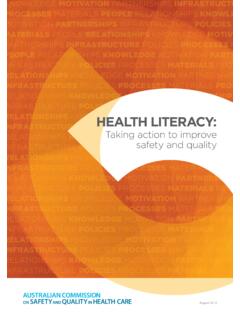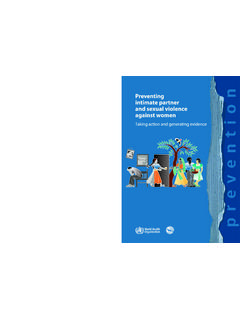Transcription of In It Together - Council of Ontario Universities
1 In It TogetherTaking action on Student Mental HealthNovember 2017In It Together taking action on Student Mental Health1 Providing effective support for mental health challenges is one of the most pressing issues on post-secondary campuses many respects, this is because Ontario has made significant progress in its approach to mental stigma traditionally associated with mental health issues is finally diminishing. There is growing recognition that a diagno-sis for clinical depression is no more a cause for embarrass-ment than the discovery of a physical, more visible change in attitude is especially important at Ontario s col-leges and Universities , as 75 per cent of mental health disorders first appear before the age of 25 (Kessler et al., 2005).Suicides and attempted suicides are no longer subjects to be avoided.
2 On today s campuses, frank discussion is en-couraged and services are offered 24/7 to try to proactively prevent such who are struggling to cope with anything from anx-iety to addictions are actively encouraged to seek help and increasing numbers of students are show just how much the situation on Ontario s cam-puses has changed. At colleges and Universities , the number of students with identified mental health disorders has more than doubled over the past five effectively is particularly important at Ontario s col-leges and Universities because many of the students with mental health issues are living on their own for the first time in their lives. The increased responsibility for making critical decisions can leave students feeling overwhelmed, isolated and illness can make it difficult for students to relate to others and increase students loneliness and isolation.
3 Students with mental health issues may also experience problems with their physical health, such as sleep difficulties and exhaustion (Mayo Clinic).Throughout Ontario , colleges and Universities have made men-tal wellness a pri this has created escalating pressures on institutions whose core mandate is to provide higher education and training. Col-leges and Universities are not treatment and Universities are standing with their students, but th ey cannot meet this challenge alone. It s time for Ontario to pull Together and adopt a comprehen-sive, holistic approach that includes government, educators, health-care providers and community organizations. Students must have access to a suite of supports and services that address the spectrum of student mental health needs. If we re in it Together , taking a new approach to mental health can make a difference for everyone.
4 Recognizing that Ontario must be proactive in addressing cur-rent challenges and responding to future challenges, the College Student Alliance, the Ontario Undergraduate Student Alliance, Colleges Ontario and the Council of Ontario Universities have come Together to develop an action plan on post-secondary student mental health based on three key , we have identified priorities and recommendations to guide and strengthen the delivery of mental health services for post-secondary students across the province. Student mental health:We all play a roleThe Spring 2016 National College Health Assessment (NCHA), a national online survey that collects information on students health behaviours, attitudes, and perceptions, indicated that depression, anxiety and suicide attempts are increasing among Ontario s post-secondary students.
5 46% of students reported feeling so depressedin the previous year it was difficult to function(increased from 40% in 2013); 65% of students reported experiencingoverwhelming anxiety in the previous year (upfrom 58% in 2013); 14% had seriously considered suicide in theprevious year (up from 11% in 2013); of students reported a suicide attemptwithin the previous year (up from in 2013); 9% had indicated that they had attemptedsuicide, but not in the previous It Together taking action on Student Mental Health2 Principles, priorities and recommendationsPRINCIPLE 1 Improving student mental health requires a whole of community approach with clearly defined roles and responsibilities of government ministries, post-secondary institutions, student associations, health-care providers and community have meaningful impact, mental health services for post-secondary students must be part of a broader circle of care that is flexible, adaptable and responsive.
6 As the demand for mental health services on campuses continues to grow, it is essential to develop an integrated, community-based system with strong partnerships between government, post-secondary institutions, student associations, health-care providers and community integrated approach must address the mental health and wellness needs of students and ensure supports are available for people entering and leaving the post-secondary sPost-secondary students are a priority group As a first step, post-secondary students must be recognized as a distinct population cohort, separate from children and youth and adults, with unique mental health service and support students are at a critical point in their social and psychological development, in addition to being in a transitory stage of their lives.
7 They require a unique approach and targeted services and investments. If these are not met, they are at risk of not living productive and fulfilling lives. There is a role for government, educators at all levels, health-care organizations and community services in supporting post-second-ary students with mental health issues and it is essential that those responsibilities are clearly defined. Working Together , these groups must ensure there are no gaps in more robust mental health services for post-secondary stu-dents are required, it must be recognized that there are insufficient mental health services for the general reports have found that some students will register for courses at colleges and Universities for the primary purpose of get-ting access to mental health care. This can often occur in commu-nities where services are not widely available is a clear demand for more community-based mental health services that are accessible, timely and dispersed regionally across the Ontario government s recent announcement that it will expand psychotherapy programs is a positive step forward and will alleviate some of the pressures on current services.
8 The challenge is to build on that commitment to develop a comprehensive mental health care system across the province. Recommendation The partnering organizations recommend that: The provincial government update Ontario s Comprehensive Mental Health and Addictions Strategy to formally recognize post-secondary students as a distinct population cohort. Role for government A whole of community approach to mental health starts with government clearly defining its roles and responsibilities. Each ministry involved in this issue must have clear direction for structuring and delivering services and supports for post-sec-ondary students. Given the number of ministries involved Health and Long-Term Care, Community and Social Services, Child and Youth Services, Education, and Advanced Education and Skills Development it is easy to lose sight of which government minis-try has oversight responsibility for specific services and supports for students.
9 My mental health has always been a hurdle that I have felt I was unable to overcome. Through the support of my peers and services at my institution, I have been able to pursue a successful leadership role in student government. My wish is for more students to be able to access the same resources I have in order to overcome their own obstacles and thrive. - Ariana C. St. Lawrence College studentIn It Together taking action on Student Mental Health3 Recommendation The partnering organizations recommend that: The provincial government communicate the respective responsibilities of each ministry that has a role in meeting the mental health needs of post-secondary students, ensuring there are no service gaps. Roles of health and community agencies and post-secondary institutions Over the past several years, the increase in mental health issues among students has put increasing pressure on post-secondary institutions to move beyond their academic counselling role to providing ongoing mental health and long-term support of this nature rightfully falls within the mandate of health-care providers and community agencies.
10 A distinction must be made between the triage role of post-second-ary institutions to direct students with serious or complex needs to appropriate care and the acute and long-term service provision role of health and community service boundaries for each institution, coupled with an integrated approach to service delivery, mean students will obtain faster access to mental health and social The partnering organizations recommend that: The provincial government clearly define the roles and responsibilities of health-care and community agencies and post-secondary education for student mental health. All organizations with a role in mental health, including gov-ernment, recognize that post-secondary institutions provide student wellness programming and triage students to mental health providers.









